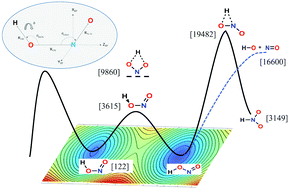A ground state potential energy surface for HONO based on a neural network with exponential fitting functions†
Abstract
The minimum energy structures, i.e., trans-HONO, cis-HONO, HNO2, and OH + NO, as well as the corresponding transition states, i.e., TStrans↔cis, TS1,2H-shift, and TS1,3H-shift, on the ground state potential energy surface (PES) of HONO have been characterized at the CCSD(T)-F12/cc-pVTZ-F12 level of theory. Using the same level of theory, a six-dimensional (6D) PES, encompassing the trans- and cis-isomers as well as the associated transition state, is fit in a sum-of-products form using neural network exponential fitting functions. A second PES is developed based on ab initio data from CCSD(T) computations extrapolated to the complete basis set (CBS) limit. The PES fits, based on 90 neurons, are accurate (RMSEs ≈ 10 cm−1) up to 10 000 cm−1 above the energy minimum. The PESs are validated by computing vibrational energies using block improved relaxation with the multi configuration time dependent Hartree (MCTDH) approach. The vibrational frequencies obtained on the PESs are compared to available experimental measurements, previous theoretical computations based on a CCSD(T)/cc-pVQZ(-g functions) PES, and anharmonic frequencies at the MP2/aug-cc-pVTZ and CCSD(T)/aug-cc-pVTZ levels of theory obtained using second-order vibrational perturbation theory. The results suggest that these are the best available PESs for HONO, and thus, should be suitable for a variety of dynamics studies, including quantum dynamics with MCTDH where the sum-of-products form can be exploited for computational efficiency.



 Please wait while we load your content...
Please wait while we load your content...